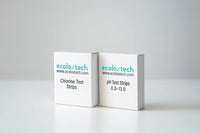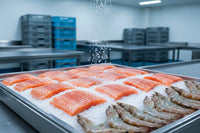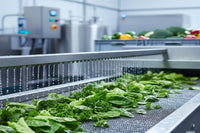When it comes to food safety, there's no room for compromise. Food processors, sanitation managers, and food safety experts are constantly on the lookout for the most effective and efficient methods to keep pathogens at bay. If you're one of them, you're in the right place. Get ready to discover how hypochlorous acid (HOCl) can transform your sanitation processes—promising to eradicate 99.99% of all pathogens while cutting your sanitation time and water consumption in half.
Traditional Methods and Their Downsides
Traditional sanitation methods in food processing facilities often involve a cocktail of chemicals, such as chlorine bleach, alcohol-based disinfectants, hydrogen peroxide, quaternary ammonium compounds (Quats), phenolic disinfectants, iodine-based disinfectants, and peracetic acid. While these methods can be effective, they come with significant downsides:
Side Effects of Traditional Sanitation Methods
- Chlorine Bleach: Effective against many pathogens, but it can be corrosive to equipment and harmful if not handled properly. It also leaves residues that can affect food quality. Chlorine bleach, for instance, can cause respiratory issues, skin irritation, and eye damage upon exposure.
- Alcohol-Based Disinfectants: These are quick-drying and effective against bacteria and viruses but are flammable and can dry out surfaces, leading to potential damage over time. Alcohol-based disinfectants, while effective at killing bacteria and viruses, are highly flammable and can lead to dry, cracked skin with repeated use. Hydrogen peroxide, though a common disinfectant, can cause skin and eye irritation, and in higher concentrations, it poses a risk of severe tissue damage.
- Hydrogen Peroxide: Strong oxidizer, effective against a wide range of microorganisms, but can be unstable and hazardous to handle.
- Quaternary Ammonium Compounds (Quats): Effective against bacteria, viruses, and fungi, but can leave residues that may become toxic over time. Quaternary ammonium compounds (Quats) are known to induce allergic reactions and respiratory issues, particularly in individuals with pre-existing conditions like asthma.
- Phenolic Disinfectants: Effective but can be harmful to both humans and the environment. Phenolic disinfectants, though powerful against a broad range of pathogens, can be corrosive and can lead to severe skin and mucous membrane irritation.
- Iodine-Based Disinfectants: Effective but can stain surfaces and are not always suitable for all food processing environments. Iodine-based disinfectants, while effective, can cause allergic reactions and are also potentially hazardous if ingested.
- Peracetic Acid: Effective and environmentally friendly, but can be corrosive and irritate the skin and respiratory system. Peracetic acid, while being a strong oxidizing agent, can lead to respiratory distress, skin burns, and eye injuries upon exposure.
How is Hypochlorous Acid Superior to All Other Sanitizers?
Hypochlorous acid (HOCl) stands out as a superior sanitizer due to its effectiveness, safety, and eco-friendliness. HOCl is a weak acid naturally produced by our white blood cells to fight infections, making it a powerful yet gentle disinfectant.
HOCl vs. Other Sanitizers
Chlorine Bleach vs. HOCl
- Effectiveness: Both are effective against a wide range of pathogens, but HOCl is less corrosive and safer to handle.
- Residue: HOCl breaks down into harmless substances like water and salt, leaving no harmful residues.
- Safety: HOCl is non-toxic and non-irritating, making it safer for workers and food products.
Alcohol-Based Disinfectants vs. HOCl
- Effectiveness: HOCl is effective against a broader range of microorganisms, including spores.
- Safety: Unlike alcohol-based disinfectants, HOCl is non-flammable and doesn't dry out surfaces.
- Environmental Impact: HOCl is more environmentally friendly, breaking down easily without polluting.
Hydrogen Peroxide vs. HOCl
- Stability: HOCl is more stable and easier to store and handle.
- Effectiveness: Both are effective, but HOCl is gentler on surfaces and equipment.
- Safety: HOCl is less hazardous to handle, reducing the risk of accidents.
Quaternary Ammonium Compounds (Quats) vs. HOCl
- Residue: HOCl leaves no toxic residues, unlike Quats which can accumulate and become hazardous.
- Effectiveness: HOCl has a broader spectrum of effectiveness against bacteria, viruses, and fungi.
- Safety: HOCl is non-toxic and non-irritating, making it safer for workers and food products.
Phenolic Disinfectants vs. HOCl
- Environmental Impact: HOCl is much more environmentally friendly, breaking down into harmless substances.
- Safety: HOCl is non-toxic and non-irritating, while phenolic disinfectants can be harmful to both humans and the environment.
- Effectiveness: Both are effective, but HOCl is safer and easier to handle.
Iodine-Based Disinfectants vs. HOCl
- Staining: HOCl does not stain surfaces, unlike iodine-based disinfectants.
- Safety: HOCl is non-toxic and non-irritating, making it safer for workers and food products.
- Effectiveness: Both are effective, but HOCl is gentler on surfaces and equipment.
Peracetic Acid vs. HOCl
- Corrosiveness: HOCl is less corrosive, prolonging the life of equipment.
- Safety: HOCl is non-irritating and safer to handle.
- Environmental Impact: HOCl breaks down into harmless substances, making it more environmentally friendly.
Ozone vs. HOCl
- Stability: HOCl is more stable and easier to store and handle.
- Effectiveness: Both are effective, but HOCl is safer for workers and food products.
- Safety: HOCl is less hazardous to handle, reducing the risk of accidents.
Benefits of Utilizing HOCl in Food Processing
- Eradicates Pathogens: HOCl is highly effective against a wide range of pathogens, including bacteria, viruses, and fungi.
- Reduces Sanitation Time: HOCl works quickly, significantly reducing the time needed for sanitation processes.
- Cuts Water Consumption: HOCl requires less water for rinsing, helping to conserve this precious resource.
- Eco-Friendly: HOCl breaks down into harmless substances, making it an environmentally friendly choice.
- Safe for Workers: HOCl is non-toxic and non-irritating, creating a safer work environment.
- Preserves Equipment: HOCl is less corrosive, prolonging the life of your equipment and reducing maintenance costs.
- Improves Food Safety: By effectively eliminating pathogens, HOCl helps ensure the safety and quality of food products.
- Cost-Effective: With reduced sanitation time, water usage, and equipment wear and tear, HOCl can save food processors money in the long run.
In the quest for the ultimate solution to food processing sanitation, hypochlorous acid (HOCl) emerges as a clear winner. Its ability to eradicate 99.99% of pathogens, coupled with its safety, efficiency, and eco-friendliness, makes it an invaluable tool for food processors, sanitation managers, and food safety experts alike.
By integrating HOCl into your sanitation processes, you can achieve superior food safety standards while reducing time, water consumption, and overall costs. It's time to revolutionize your sanitation practices and ensure the highest quality of food products.





